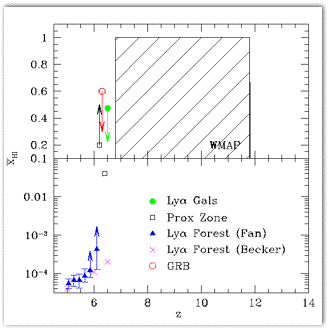
Home
Research
The
Group
Publications
Talks
Teaching
Links
| |
Research Interests:
The High-Redshift Universe
Reionization is the process by which galaxies and quasars
ionized hydrogen in the intergalactic medium (IGM). It is a milestone
event in the history of the Universe, because it marks the time at
which structure formation affected every baryon in the Universe.
Beyond that point, the IGM became transparent to ultraviolet photons,
allowing galaxies to "see" each other all the better.
|
Observations now suggest that reionization occurred sometime around
redshifts 6.5-12 (or about 500 million years-1 billion years after the
Big Bang), although the uncertainties are still large (see the Figure
at right, taken from our recent review,
which shows ). The most powerful probes to date are high-redshift
quasars found by the Sloan Digital Sky
Survey and measurements of the cosmic microwave background (CMB)
by the Wilkinson Microwave
Anisotropy Probe. Unfortunately, neither can yet provide a
decisive description of reionization: quasars are too rare, and the
CMB provides only an integrated background measure.
This is unfortunate because reionization offers a wealth of
information on the first sources of light in the Universe. In
particular, the "geometry" of reionization - how large the HII regions
surrounding galaxies and quasars grow, and how they relate to the
underlying density field, can teach us about star formation in the
first galaxies and how those galaxies form from the IGM. Together
with Matias Zaldarriaga and Lars Hernquist (as well as their
students), I have developed a model predicting the sizes and locations
of these ionized bubbles. The figure below shows three views of a
simulation of reionization (courtesy O. Zahn) illustrating how the
bubbles grow (the orange colorscale shows the density of neutral gas;
black regions are ionized and blue dots show the locations of
galaxies). The movie below shows the Universe as it is being ionized;
the colorscale actually shows the brightnes in the 21 cm transition.
|

|
Our group focuses on understanding the principles behind the bubble
geometry as well as what observations can teach us about it (and thus
about the first galaxies and the IGM). Some of these methods are:
21 cm Observations of the High-Redshift IGM: Probably the most
exciting possibility is the 21 cm transition - so exciting that it
deserves its own page!
Quasar and GRB Spectra: The so-called Lyman-alpha
forest is an unparalleled probe of intergalactic hydrogen at
moderate redshifts. Unfortunately, by z~6 neutral gas has become
common enough that the absorption is completely saturated - even
though less than 1% of the hydrogen is actually neutral! Thus this
technique can only probe the late stages of reionization. However, it
offers a much more detailed view of small scale structure than any
other potential probe. It is therefore ideally suited to studying the
end phases of reionization, when the fine structure of the cosmic web
begins to control the evolution of the ionizing background. Moreover,
the detail of the spectra allows us to study unique features of the
ionizing background, such as the "proximity zone" around each quasar
and the damping wing of absorption, as well as heavy elements like
oxygen, which can also probe the ionizing background.
Lyman-alpha Galaxy Surveys: A complementary probe takes
advantage of recent advances in high-redshift galaxy surveys that use
their bright Lyman-alpha lines, which form because most ionizing
photons are absorbed inside the galaxy and recycled into Lyman-alpha
photons. If these photons travel through neutral gas, they will be
absorbed and scattered away from the line of sight - thus, we expect
this technique to fail if we push far enough back in reionization.
However, if the galaxy sits inside a large ionized bubble, the photons
can redshift out of the Lyman-alpha resonance before encountering any
neutral gas. Thus these surveys offer the opportunity to map the
bubble structure (albeit indirectly) because large bubbles will
contain many Lyman-alpha-bright galaxies while small bubbles will
contain few. However, telescope technology - and in particular the
field of view - must improve significantly before such dreams can be
realized fully.
CMB Measurements: The CMB also contains a wealth of
information about reionization. On large scales, scattering by free
electrons along the line of sight generates (relatively) large
polarization - it is this signal that WMAP has measured. It
constrains the total column of ionized gas and hence the mean
reionization redshift. However, the ionized bubbles also induce an
inhomogeneous scattering component through the "kinetic
Sunyaev-Zeldovich effect" that can be observed in arcminute-scale
temperature fluctuations. The next generation of ground-based CMB
telescopes hope to observe this signal.
|

